Did you know that 38 percent of internet users will stop interacting with a website if they don’t find the layout appealing? User Design (UI) and User Experience (UX) go hand in hand. This is especially true in a world where users have very specific expectations when they visit a website, download an app or install software. This is why the User Experience needs to be at the core of the design development process
Finding a balance between what users want and an uncluttered experience
Business users are bringing their consumer purchasing power with them to the office. They expect instantaneous results. Designers need to find a balance between meeting this expectation and creating an interface that isn’t cluttered.
Remember the KISS principle in mind when working on your designs. KISS stands for Keep it Simple, Stupid. If a product is easy to understand and use, users will have a positive experience and adopt the product. Complexity is desirable only when it improves the user experience.
Put yourself in your consumers shoes. Ask yourself where a user would logically expect to find something. There are a few additional things to keep in mind besides the KISS principle for a successful design:
You can organize elements by logical categories or adopt a top-to-bottom approach and group elements that a user would need while going through a workflow.
Users are already familiar with naming conventions and with icons. Take advantage of this to create a navigation experience users will quickly familiarize themselves with.
Provide documentation with step-by-step guides, useful tips and an easy search feature so users can find exactly what they need instead of going through a lengthy user manual.
What do users want?
Don’t make the mistake of focusing on what competitors are doing when designing a new product. Users will compare your products to what competitors offer and design will be one of the things they compare, but you need to develop your product around what users want since competitors are not necessarily meeting their expectations.
Every design should start with these three steps to better identify user expectations:
- Define goals and priorities for the design based on analytics and surveys that give you insight into how users do with your products.
- Conduct research to better understand the challenges user face and the problems they want to solve with your products. Feedback is a great place to start your research. ESPN was able to boost revenues by 35 percent by simply redesigning their homepage based on suggestions made by users!
- Develop user personas and scenarios based on your research. You can then work storyboards and experience maps to start sketching your design.
You also need to understand how major players like Netflix and Amazon have transformed user expectations when it comes to designs and interfaces. Amazon has set a new standard for shopping sites by delivering a personalized shopping experience, while Netflix has changed the way internet users search for media and consume it.
How to create a successful user experience
The key is to work with a collaborative design process. You should have communication and collaboration between your designers, your developers and the users. Once you have created user personas and scenarios, you can start identifying goals and challenges and brainstorm to find ways to address each goal and challenge.
These ideas will then become wireframes for your design, and you will be able to develop a prototype. Get some feedback from developers to identify potential pain points with the prototype as early as possible.
The next steps consists in developing a UI that is consistent with the backend design, and analyzing the final product to look for ways to improve it. Incorporate feedback from users as much as possible throughout this process. Beta testers will help you improve your design, but you can also conduct some interviews to get some feedback at the wireframe stage.
In case you haven’t recognized it yet, this approach corresponds to the agile methodology. If you want to improve the designs you create, you need to change the way you develop these designs. You need to adopt a cyclical approach that incorporates UX and feedback as much as possible to optimize each element of your design in function of what users want and expect.

